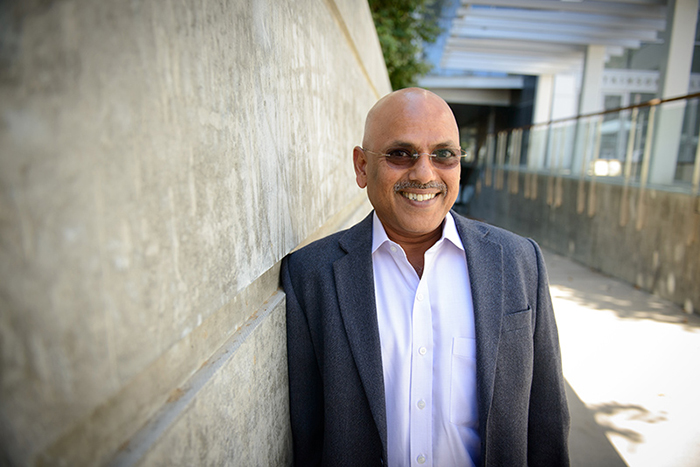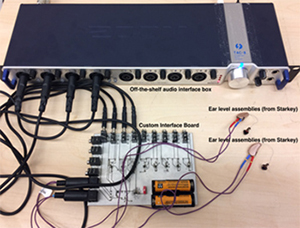
UC San Diego, SDSU to Roll Out Research Platform to Improve Hearing-Aid Technologies
Published Date
By:
- Doug Ramsey
Share This:
Article Content

Qualcomm Institute research scientist Hari Garudadri is principal investigator on the project to develop one desktop and one wearable Open Speech Platform to enable field research by audiologists and engineers who develop algorithms to improve hearing aid intelligibility. Photo by Alex Matthews/Qualcomm Institute
A team of engineers from the University of California San Diego and audiologists from San Diego State University has set out an ambitious timetable for delivering two new electronic platforms to dramatically improve and accelerate research on better hearing aids. Led by Qualcomm Institute research scientist Harinath Garudadri as well as UC San Diego co-principal investigators and Electrical and Computer Engineering (ECE) professors Patrick Mercier and Bhaskar Rao, the UC San Diego-SDSU team has been awarded a $2.1 million grant from the National Institute on Deafness and Communication Disorders (NIDCD), one of the National Institutes of Health (NIH).
The grant is set to be announced this week at the International Hearing Aid Research Conference (IHCON), a venue for scientists and engineers who develop hearing aids and other technologies to help in the treatment of hearing impairment. The weeklong meeting is taking place through August 14 near Lake Tahoe, Calif. The six NIDCD awards follow the funding agency’s Open Speech program solicitation. On the sidelines of the conference, NIDCD will brief attendees on the Open Speech program and representatives of each winning project will make a short presentation based on a two-page data sheet about each platform. [Note: The data sheet can be downloaded from the home page of the Open Speech Platform project at http://openspeechplatform.ucsd.edu.]
Qualcomm Institute’s Hari Garudadri will speak on behalf of the UC San Diego/SDSU group in announcing details regarding their “Real-Time, Open, Portable, Extensible Speech Lab.” The research scientist will add other adjectives to that enumeration of the proposed platforms’ characteristics. “We will develop an open, reconfigurable, non-proprietary, wearable, real-time speech processing system suitable for audiologists and hearing-aid researchers to investigate new hearing-aid algorithms in lab and field studies,” says Garudadri. “In line with the spirit of the Open Speech program, we aim to accelerate hearing healthcare research and facilitate translation of technological advances into widespread clinical use.”
In his presentation tentatively scheduled for Thursday, August 11, Garudadri will spell out plans for finalizing a desktop lab, before shrinking it to fit on a tiny wearable device with an embedded processor such as Qualcomm’s Snapdragon chip sets. “Snapdragon processors have been optimized for low power, a powerful digital signal processor [DSP], a general-purpose CPU, and multiple wireless connectivity options,” notes Garudadri.
Adds co-PI Patrick Mercier: “The tasks related to a hearing aid would require about 20 percent of the resources of the DSP, so that would still leave adequate resources to serve all the advanced signal processing functions on the wearable device.”

Hardware for interfacing ear-level assemblies to a laptop
In line with the two-year grant, Garudadri anticipates an 18-month timetable for release of the two new electronic platforms — the desktop version in early 2017, and the wearable, chip-based platform by the end of 2017. “We’ve already implemented the system in ANSI-C and it runs in real-time with less than 10 milliseconds of latency on a high-end MacBook,” said Garudadri, who worked for 16 years in signal processing at Qualcomm, Inc., prior to joining UC San Diego’s Qualcomm Institute in 2014. “We plan to release the software in source code, PCB schematics, Gerber files, parts list and so on in the first quarter of 2017.”
According to the research scientist, the initial desktop system is based on a signal processing chain supporting hearing-aid functions including sub-band amplification, dynamic range compression, feedback cancellation and remote control for investigating self-fitting methodologies. There is also a custom interface board and an off-the-shelf audio interface box (pictured) for interfacing to ear-level assemblies. The remote is then implemented on an Android device and the protocol stack is extensible beyond controlling the gain and compression parameters.
In collaboration with SDSU audiologists Carol Mackersie and Arthur Boothroyd, the team will study self-fitting methodologies. The engineering team is soliciting collaborations with audiology and hearing science labs interested in improvements in intelligibility in multiple-noise environments, development of objective metrics to characterize hearing loss and to quantify improvements in intelligibility, binaural processing to improve intelligibility, and more.
In addition to Garudadri and co-PIs Mercier and Rao, the UC San Diego team includes collaborator Rajesh Gupta, a professor in the Computer Science and Engineering department and associate director of the Qualcomm Institute, whose research is focused on energy efficiency and mobile computing issues in embedded systems. Student researchers on the project include two ECE grad students — Ph.D. student Ching-Hua Lee and M.S. student Swaroop Gadiyaram — as well as CSE Ph.D. student Sean Hamilton, who is also a software engineer at Tortuga Logic, a chip design security startup founded by CSE Prof. Ryan Kastner and CSE alumnus Jason Oberg (M.S., Ph.D. ’12, ’14). Rounding out the Open Speech Platform staff are Qualcomm Institute software developer Justyn Bell, and audio engineer Raphael Melgar, who works in QI’s Sonic Arts R&D group.
(Ph.D. student Ching-Hua Lee will also be in Lake Tahoe. He is presenting a joint poster at IHCON with QI’s Garudadri, ECE Prof. Bhaskar Rao and University of Colorado, Boulder Prof. James Kates on “Speech quality and stable gain trade-offs in adaptive feedback cancellation for hearing aids.” Kates is also a consultant on the Open Speech Platform project.)
In keeping with the funding agency’s guidelines, the team has committed to supporting deployment of the new platforms at a minimum of three outside labs involved in hearing healthcare. One has already been selected, and Garudadri expects to begin speaking with other potential user communities at IHCON. Expressions of interest will also be submitted online through the project website. While the commitment is to support three labs with hardware, software and technical support, Garudadri notes that the team anticipates that the technology will be made available to many more institutions and independent researchers than just the three mandated labs.
Share This:
You May Also Like
Stay in the Know
Keep up with all the latest from UC San Diego. Subscribe to the newsletter today.


